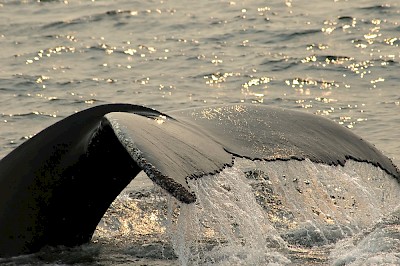Wildlife of Nootka Sound
Cruising aboard the MV Uchuck III is a great way to see marine wildlife in their natural habitat.
Sea Otter
Sea otters are the smallest of marine mammals. A fully grown sea otter is the size of a German Shepherd dog, and can weigh up to 45 kg. Sea otters depend upon a thick fur coat and a high body temperature to stay warm in their chilly ocean environment. They have the thickest fur of any mammal, up to 160,000 hairs per square cm. To maintain their high body temperature, sea otters eat up to 1/4 of their weight in food each day. Sea otters are often confused with their smaller cousin, the river otter, which despite the name, are often found in the marine environment. You may see river otters running along rocky shores or snoozing on docks.
Female sea otters bear a single pup, usually in early spring. The pup is normally born at sea and remains with its mother for about 6 months. The males are not involved in raising the young. Sea otters are fairly social animals, so it is not uncommon to see a group, or raft, of up to 100 sea otters. Sea otters feed on invertebrates, animals such as snails, clams, octopus, crabs, mussels and sea urchins.
Sea urchins can devour entire kelp forests, creating areas devoid of seaweed, and are called “urchin barrens”. By eating urchins, sea otters increase the abundance of kelp, which increases near shore productivity and provides an important habitat and nursery area for many species of fish. When sea otters were hunted to extinction on our coast, the near shore ecosystem was likely altered in a dramatic manner.
Sea otters were once common throughout coastal areas of the north Pacific, ranging from northern Mexico to Northern Japan. They were hunted to the brink of extinction, in an intense maritime fur trade which lasted from the 1700’s until the early 1900’s. Sea otters were legally protected in 1911, with less than 2000 sea otters remaining throughout their range. The last known otter to inhabit British Columbian waters was shot off of Grassy Island, near Kyuquot, in 1929. Sea otters were re-introduced to British Columbia from 1969 to 1972. A total of 89 sea otters, captured in Alaska, were released in the Bunsby Islands, just northwest of Kyuquot. The population has grown at a rate of about 19% per year. In 1995, there were at least 1450 sea otters along the west coast of Vancouver Island, many of which live within the area the MV Uchuck III travels.
So keep your eyes peeled... these engaging animals, which are surprisingly common along the Uchuck’s route, are actually one of Canada’s rarest marine mammals.
California Sea Lion
The California Sea Lion’s territory stretches from Baja California to Alaska. This playful, noisy, exuberant, quick learner is the “trained seal” of the circus. It is highly adaptable to any surrounding and uses a variety of habitats. When resting on rocks or beaches they point their noses skyward and may be seen laying atop one another. When at sea they raft together, playing and leaping clear of the surface. Their long fore flippers enable them to make powerful strokes while swimming and can reach speeds of 25 mph. They are very vocal and bark like dogs; the pups have a bleat like call. The California Sea Lion prey on schooling fish, rockfish, squid, flatfish, hake, lamprey, dogfish and salmon.
Humpback Whale
This whale is black with white patches on the flippers, bottom surface of the tail flukes and body. Males average 47 feet; females, 49 feet. Weight ranges from 25-45 tons. The head is flattened and the flippers are the biggest of any species.
They are highly acrobatic animals who breach repeatedly and have a spectacular blow of 10-13 feet ending in a beautiful haze of spray. They feed on krill and schooling fish such as herring, mackerel and cod. The humpback is usually found in small groups but have been known to gather in groups as large as 200.
Humpback Whales mate every 2+ years and after a year’s gestation period a 15 foot, two ton calf is born. Due to commercial whaling, less than 2000 of these whales are found in the northern Pacific. Now an endangered and protected species, the numbers are slowly increasing.
Killer Whale (Orca)
The killer whale is the largest species in the dolphin family. This glistening, black creature with white patches above and behind each eye, on the chin and throat extending along the belly is a stunning sight to see. The body is robust and powerful with a blunt, round head and slight beak. The males average 27 feet in length and can weigh up to 11 tons; the female 23 feet, 8 tons. The orca is an extremely fast swimmer, exceeding speeds of 30 mph, it spyhops and breaches often, making it a wonder for whale watchers. Its blow is up to 10 feet high and often has a loud, explosive sound.
This intelligent creature remains in a family pod of 5 to 20 for life. They will eat anything that swims or floats (except humans) including seabirds, turtles, other cetaceans (including great whales), seals, sea lions, all types of fish and squid. The orca has 3 basic sound types including a click, whistle and a scream.
A population of 260 killer whales frequent the waters of the BC coast. They are listed as not threatened but reduced salmon stocks may be affecting the growth of northwest populations.
Dolphins
Pacific White-sided Dolphins have a dark grey or black back broken by a white or light grey stripe along the flank. The beak, front edge of dorsal fin, flippers and flukes are dark, the belly white. This fast, powerful swimmer loves to bow ride and surf, they can often be seen leaping and somersaulting. They are nearly always found in groups of less than 50 animals. Their primary foods source is salmon, squid and small fish. This animal is considered common and not endangered.
Bald Eagles
This large eagle is a blackish in colour with a white head and tail and a heavy yellow bill. The call is a squeaky cackling with thin squeals. Look for eagle nests, known as aeries, in tall trees or on top of a cliff; here two or three white eggs are laid. This bird is primarily a fish eater but also eats carrion and crippled waterfowl.
Black Bear
The black bear is a bulky and thickset mammal. Approximately 150 cm long and with a height at the shoulder that varies from 100 to 120 cm, an adult black bear has a moderate-sized head with a rather straight facial profile and a tapered nose with long nostrils. The ears are rounded and the eyes small. The tail is very short and inconspicuous. A black bear has feet that are well furred on which it can walk with the entire bottom portion of the foot touching the ground. The normal colour is black with a brownish muzzle and frequently a white patch below the throat or across the chest.
Grizzly Bear
Grizzly Bears are not native to Vancouver Island but they are nearby. They are found all along BCs Northwest Coast. Most notably, Knight Inlet, is home to Glendale Cove which boasts one of the largest concentration of grizzly bears in British Columbia. The cove offers nutrient rich sedge grass in the spring and early summer, an abundance of berries in the late summer and fall, and of course, the large run of salmon up the Glendale River which is the bears’ staple diet before hibernating for the winter. Wilderness tour operators can whisk you into the area to witness this amazing site.
















